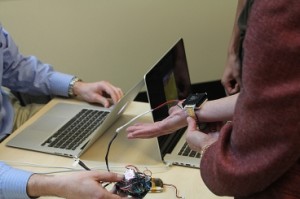It’s not necessary to warm an entire building if people are cold – what if you could instead warm each person individually, saving enormous amounts of money for heating unused space? A team of engineering students at MIT have turned this idea into reality.
Using a model that looks like a wristwatch band, the prototype created by team Wristify is meant to cool or heat a singular person at a pulse point that can change the perceived temperature of the entire body. If you have ever run your hands under cool water on a hot day, you know that cooling your wrists can have an immense impact on what temperature your entire body feels. This is because there are blood vessels in your wrist that are very close to the outer layer of skin. When you induce a temperature change at the wrist, it changes the temperature of the blood rushing through your veins at that point. That blood then circulates throughout the rest of your body, bringing with it a different amount of heat, whether cooler or warmer.
The students found that if the body is heated at least 0.1 C every second, a person can perceive a temperature change in their whole body. Although the temperature change seems small, because it is so quick our bodies feel they have gotten a few degrees warmer or cooler. The students claim that their device can change the temperature 0.4 C per second.
The final prototype is chargeable for up to 8 hours by a lithium polymer battery. The model includes a heat sink, which is used to lower the temperature of the device itself. It allows heat to dissipate away from the device. The control system is automatic; it records the temperature of the both the body and the outside environment so it knows when to increase or decrease the temperature.
The team won $10,000 at a competition for sustainable engineering. They hope that the device can be used in large buildings, where each person has a personal device. Rather than using energy to change the temperature in the entire building, a smaller amount of energy can be devoted to each person individually. It is estimated that if a building lowers its temperature by 1 degree Celsius, it can reduce its energy consumption by 100 kW hours per month, a sizable change.
As with any new device, the team will need to find a way to scale up production if they intend to make a sizable reduction in energy use. It remains to be seen how effective the wrist devices are in practice. How cold can you make a building before the device makes no difference? Are the batteries and materials of the device sustainable for long term use?


